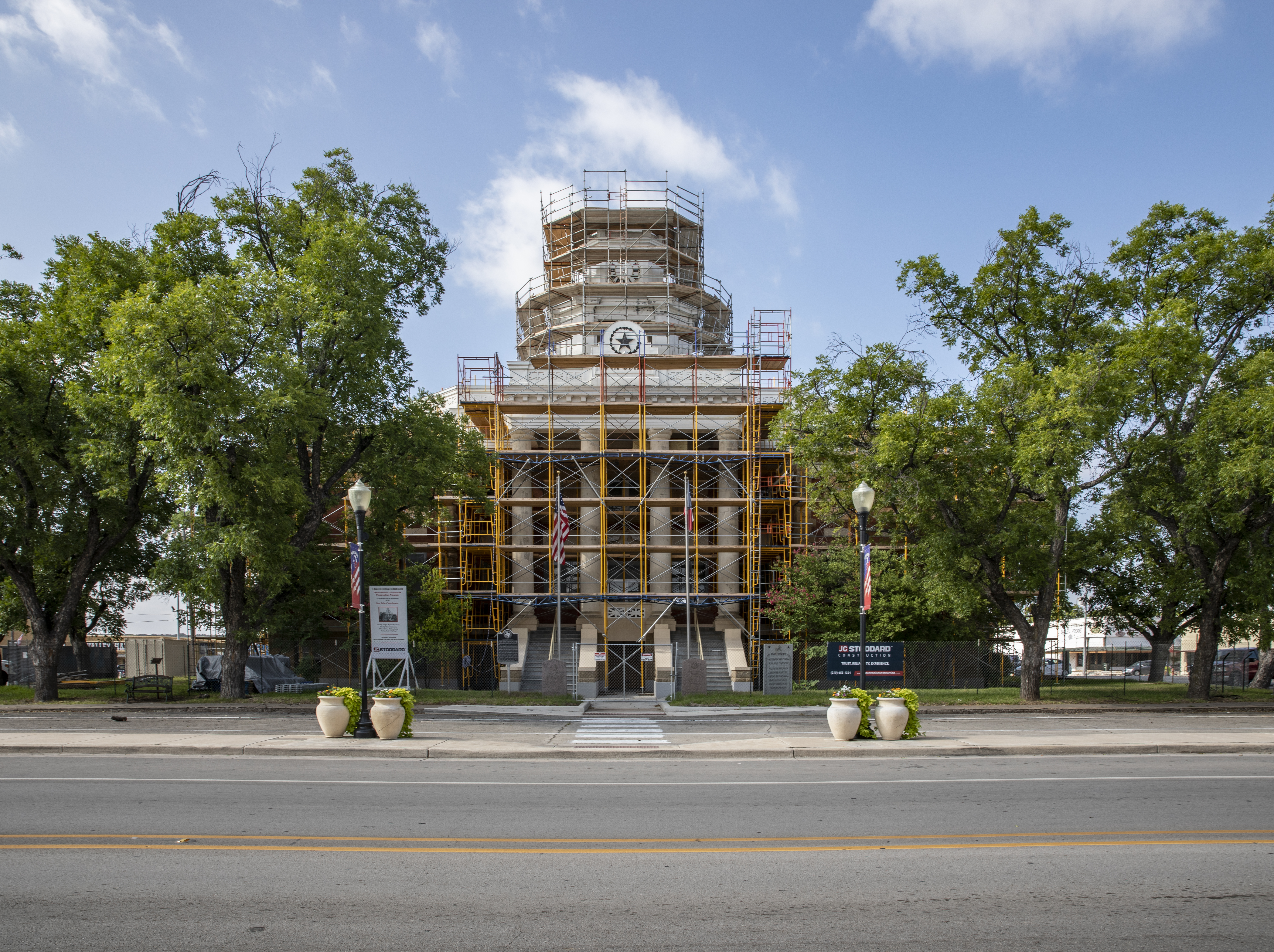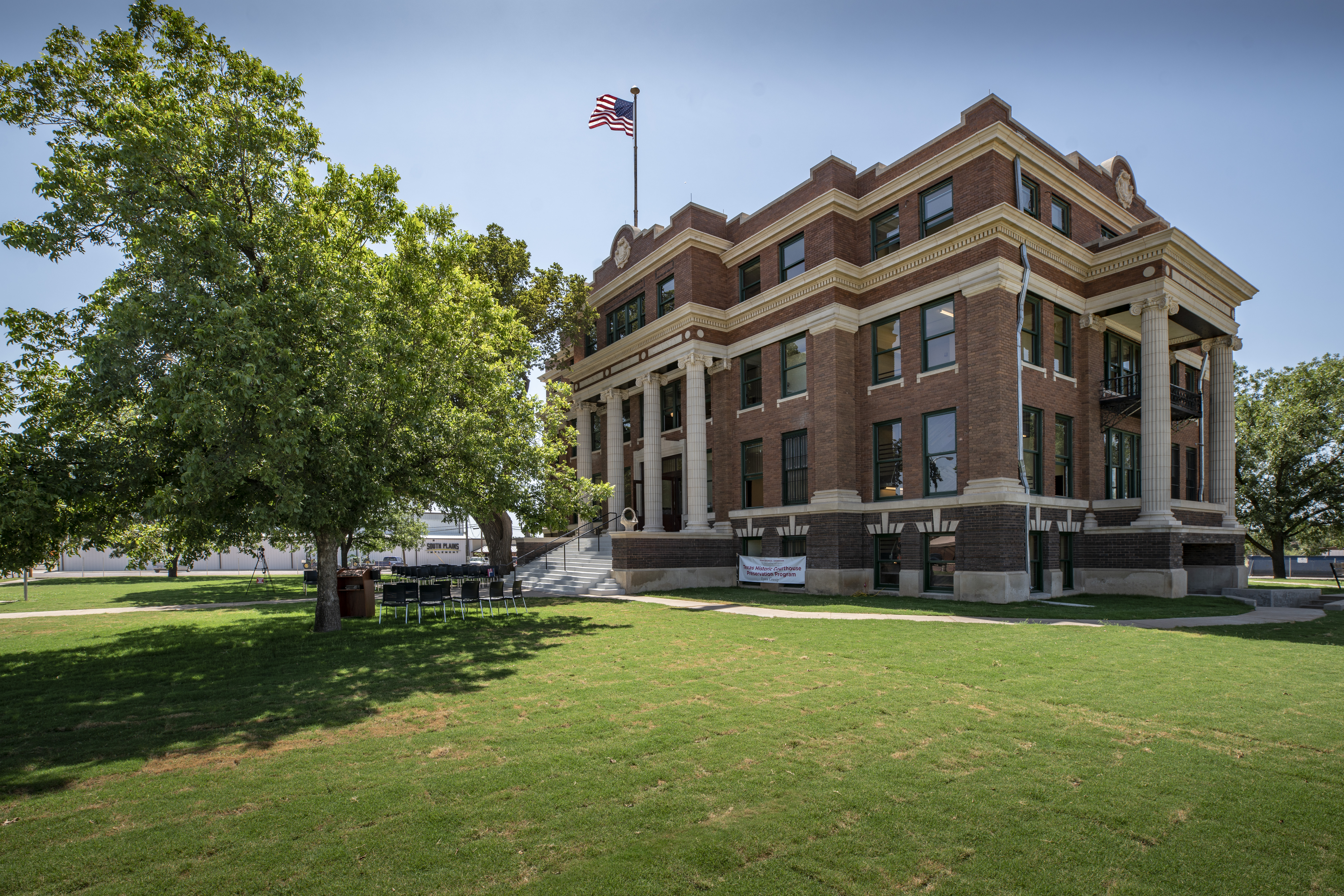County Judges Share Experiences with State Courthouse Grant Program
You may have heard about the Texas Historic Courthouse Preservation Program, the Texas Historical Commission’s (THC) award-winning matching grants program that helps counties restore historic courthouses. But we wanted you to hear directly from participants. Recently, we asked County Judges from across the state to provide honest feedback about what it was like to fully restore their courthouses as part of the program. Judge Byron Theodosis of San Saba County, Judge H.M. Davenport of Navarro County, former Judge Samye Johnson of San Augustine County, and Judge Mike Braddock of Lynn County were happy to assist.
Why Participate?
Sometimes the decision to leverage county funds with a THC grant is a practical one. Tackling repairs and critical upgrades or dealing with deferred maintenance costs over time can often equal or exceed the required match for a comprehensive restoration. But sometimes the decision goes beyond financial sense. Some participating counties go to extraordinary lengths and endure significant challenges for the less-practical reason of proudly preserving the history and artistry of a community centerpiece.
For many years, Lynn County citizens aspired to preserve the historic town square of Tahoka, starting with the courthouse at its heart. Like many counties, the goal could not have been achieved without THC assistance, even after years of fundraising. The county finally attained its ambitious goal, including the removal of hazardous materials and improving the appearance of the

entire courthouse square by regaining property that had been captured by a state highway in the 1930s. The courthouse was rededicated last July.
In San Saba County, “time was ticking for our 100-year-old courthouse, with original wiring and other serious infrastructure threats making its future a growing concern,” lamented Theodosis. Like many counties funded through the program, San Saba County is rural with a low tax base, making a fully restored courthouse seem to Theodosis “like an impossible dream,” that is until THC grants became available in 2000, when the county submitted its first application. The dream will finally be realized when the county rededicates its courthouse early this year.
Although the condition of the Navarro County Courthouse was fair when its restoration began, there were still major plumbing problems, there had been a small electrical fire in the judge’s office, and the 1950s chiller caused constant maintenance headaches and cost a fortune to operate. The county would have spent at least a few million dollars to address deferred maintenance and code compliance issues. Its constituents made the wise decision to use that money as a match to fully restore the building when they voted to approve a bond.
The San Augustine Garden Club assisted its county with grant application efforts, with full support of the San Augustine County Commissioners Court and inspiration from the inclusion of its 1927 courthouse in an article about Texas courthouses on the National Trust for Historic Preservation’s Most Endangered Places list. Later, the club succeeded in providing two-thirds of the county’s match toward the building’s full restoration through a major fundraising effort.

Any Controversies?
While some Commissioners Courts hesitate to proceed with a full restoration due to fiscal concerns, anxiety is consistently transformed into pride when people see the finished product – a beautiful and functional building that beckons locals and tourists to a once-forgotten downtown. In San Saba County, the court and most of the community saw the financial sense of accepting a grant that paid for more than two-thirds of its planning and construction costs. But not all courts feel so confident about taking a perceived risk.
A few Navarro County Commissioners initially hesitated, but the court voted to move forward after receiving an estimate for the minimum-required repairs to the courthouse that exceeded its match toward a grant-funded full restoration, as well as assurances that the bond repayment had a fixed tax rate. The county carefully engaged the community before putting a bond on a ballot, which passed easily. And according to Davenport, “any public dissention disappeared very soon after the rededication.”
After completion of grant-funded bid documents to restore the San Augustine County Courthouse, Commissioners Court support to pursue a construction grant waned. But when local proponents filled the district courtroom to witness the court’s vote, it reluctantly decided to proceed. “With the full restoration completed, every resident and friend of San Augustine County was thrilled and pleased with the result of the restoration,” shared Johnson. “Perhaps the most successful aspect of the courthouse restoration was the excitement and enthusiasm created as our people saw the transformation of our moldy, deteriorating courthouse into its magnificent original appearance.”
Braddock noted that some Lynn County residents believed they could build a new, bigger facility for the cost to restore the historic courthouse. But once the project was completed, some of those same people complimented the restoration, and any remaining controversy quickly dissipated.
Greatest Challenges?
In any restoration project, unforeseen conditions can emerge increasing costs and causing delays. The THC encourages grant recipients to set aside money to cover unanticipated costs, but

sometimes cost overruns exceed that contingency. In those cases, the THC will consider requests for supplemental funding to address issues that were unknown during planning. In Navarro County, code officials required additional fire protection after a construction bid had already been accepted, increasing the project cost and timeline. The THC agreed to provide supplemental funding to cover its portion of the added scope.
Integrating systems into a building while retaining its historic appearance is always a puzzle, as in the case of the Lynn County Courthouse. According to Braddock, the arrangement of all required services behind walls and above ceilings was the most difficult aspect of the project.
Direct Benefits?
In addition to restoring the historic appearance of courthouses, the THC always aims to provide functional, safe, and code-compliant buildings with increased energy efficiency. The THC allows the application of low-e films on windows, as well as interior storm inserts. Both reduce heat gain, while the latter improves sound insulation from street noises. During a full restoration, more efficient mechanical, electrical, and plumbing systems are installed, which significantly reduce utility and water bills.
The restoration of the San Saba County Courthouse included important technological upgrades such as improved energy conservation, increased security, ample task lighting, and the installation of acoustical treatments and modern audio-visual systems in both courtrooms. A new electrical system was critical since the building had experienced a smoldering insulation fire the night before Christmas 2007; this was addressed with an emergency grant in 2012. All those useful improvements “coupled with the restored elegance of the grand old structure, have eclipsed concerns that we were simply carrying forward old problems” attested Theodosis.
For Navarro County, critical improvements that made the stunningly restored courthouse more useful included fire suppression and protection systems, fire-truck access, the addition of handrails on stairs, a new elevator, accessible restrooms, new basement lighting, an updated accessible ramp, new audio-visual equipment, and acoustical treatments in both courtrooms, as well as new mechanical, electrical, and plumbing systems. Comparing costs in the two years after the restoration, the county used 25 percent less electricity and 60 percent less water.
Before its restoration, there was major concern that the antiquated 1927 wiring in the San Augustine County Courthouse would cause a fire, as had happened at several other Texas courthouses over the years.
“Our county records, many written in Spanish, go back to the early 1800s and are irreplaceable,” said Johnson, so replacing the building’s electrical system and providing a safe environment for records storage was reassuring. Visitors and occupants of the courthouse now find its climate far more comfortable, and the utility costs have been reduced.

Value-Added Benefits?
In addition to the direct benefits of a newly restored and easier-to-maintain building, participating counties across the state experience an increase in heritage tourism after restoring the courthouse at the heart of their historic business districts. Participating communities also repeatedly see increased property values on the courthouse square.
“We have hundreds of visitors through the year coming to take pictures of the building and grounds during the week and on weekends,” declared Davenport, adding, “I give tours whenever asked so I can show the building and share its history with others.” Several movie scenes have been filmed in both courtrooms and other locations within the building since its restoration. Visitors spend money in town, eat at restaurants, buy gas, and stay overnight.
“Not only has it helped to make the entire downtown more appealing and inviting to all who visit San Augustine, it caused the city to become part of the THC’s Main Street Program, which has further boosted the city’s visibility,” said Johnson. “Tour buses visit the city regularly, and they always visit the courthouse.”
By Susan Gammage
Senior Project Reviewer
Texas Historical Commission















